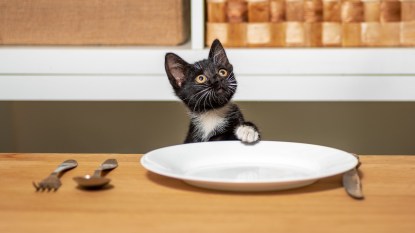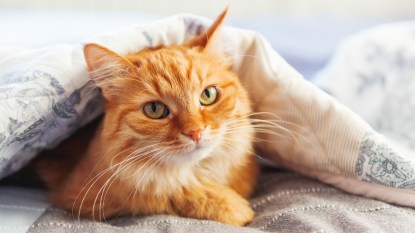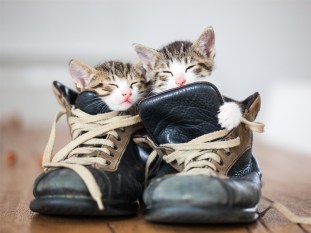Feline Bathroom Etiquette: Get Your Cat Used to Water, Stop Toiletries From Being Toys, and More

If there’s one thing everyone knows about cats, it’s this: Cats and bathrooms don’t mix. Our furry friends hate water, and if they get into the drawers of a bathroom cabinet, the cleanup could take hours. However, every kitty needs to learn a little bathroom etiquette. Training your cat to get used to water and stop playing with toiletries will become very valuable investments.
Here, learn quick “bathroom training tips” to help keep your feline healthy and happy.
Training Your Cat to Stop Playing With Toilet Paper
Argh! Fluffy left an entire roll of toilet paper shredded and strewn across the bathroom floor. To nix this naughty behavior: When you slide a new roll onto the toilet paper holder, bend and reshape the cardboard roll so it’s more of a square than a circle. That way, the paper won’t slide off the holder as easily as Fluffy tries to claw it, making the game less fun. She’ll lose interest, leaving the roll in peace instead of in pieces.
Also smart? To prevent your cat from kneading or clawing at your toiletries, try training your cat to knead something else, such as an enticing toy or mat. One we like: the Sonoma Wool Cat Mat (Buy from the Sonoma Wool Company, $16.95).
How To Get Your Cat Used to Water
Cats do keep themselves clean, but sometimes a bath is needed. If your cat is older, for example, he may need help keeping tidy. And if your cat just had a surgery, your vet may instruct your to gently bathe your pet to keep him clean.
But how in the world do you give a feline a bath? You may be able to train your pet to gradually enjoy, or at least tolerate, the experience. Try these tips to get your cat used to water (over the course of several weeks):
- Get your cat used to the sound of running water. Turn on faucets when your pet enters the kitchen. Make sure he’s around when you fill his water bowl. Reward him for sticking around with a small treat or two.
- Spend time in the bathroom with your furry friend. Play with toys in the bathroom, especially in and around the sink and bathtub. Make the space welcoming and rewarding.
- Use a damp washcloth. When your cat seems comfortable in the sink or the tub, introduce a damp washcloth. Gently rub it on his paws, his legs, and his back.
- Wet their feet. Let your cat explore a sink or a bathtub with a tiny bit of water in it. The goal is to make him comfortable with the sensation of wet paws. (Make sure that water is room temperature — not cold!)
- Dribble water over your cat’s body. Don’t jump to the powerful faucet just yet. If your cat is comfortable getting his paws wet, gently cup and dribble a little water around his legs and onto his back.
From there, you can gradually introduce cat-friendly soap and eventually give him a gentle bath. Here are a few extra tips from our readers on bathing a kitty without getting clawed:
- Add water to the tub before bringing your cat in, says Lucy Baker. This avoids the “scary” sounds of running water that make her want to latch on.
- Light a chamomile-scented candle near the tub, says Cindy Lewis. The soothing scent will help relax you and your cat.
How To Eliminate Your Kitty’s Bathroom Accidents
Your furry friend keeps peeing where he shouldn’t! To deter your cat from going anywhere other than the litter box, try these tricks:
- Clean out the litter box — your cat may not like the smell. And try a different kitty litter.
- Spray the area where your cat likes to pee with an enzymatic cleaner. It contains enzymes that will neutralize the odor and deter your cat from going there again.
- Schedule a visit with your vet. Your furry friend may have a UTI or another issue.
Also, you want to be sure you clean up every last bit of odor — but those store-bought odor eliminators are so pricey. Whip up your own cleaner by pouring:
- 5 ounces of hydrogen peroxide
- 1 teaspoon of vinegar
- 1 teaspoon of baking soda
- ½ teaspoon of dish soap
- 3 drops of orange essential oil into a spray bottle.
Then gently shake the bottle, spray generously around the affected area and let sit overnight. (Note: Test a small spot first to check for discoloration.) The ingredients work together to banish the strong odor molecules so they don’t linger. The next morning, simply vacuum up the dried powder mixture.
A version of this article originally appeared in our print magazine, First for Women.













